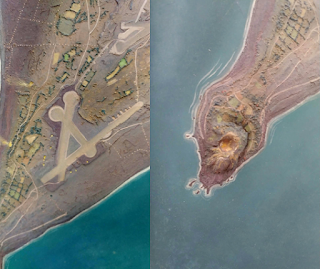The Battle of Iwo Jima
By late 1944, the outcome of the war with Japan was no
longer in doubt. Though Allied victory was inevitable, other questions remained.
What would it take to force a Japanese surrender? How could this be
accomplished while minimizing Allied casualties?
Allied strategy was deeply influenced by the split command
arrangement that produced two simultaneous offensives across the Pacific. The
first, controlled by the Army, ran through the southwest Pacific and included
as one of its major objectives the liberation of the Philippines. The second
was a drive across the central Pacific led by the Navy. The Army’s Chief of
Staff, General George C. Marshall, believed that the next target of the
island-hopping campaign should be Formosa. Such a campaign would fall under the
control of General Douglas MacArthur, the head of South West Pacific Area.
Admiral Chester Nimitz, Commander-in-Chief of the Pacific Fleet and Pacific
Ocean Areas, wanted to take a more direct approach to Japan, invading Iwo Jima
followed up by landings on Okinawa a few weeks later.
General Henry H. “Hap” Arnold of the Army Air Forces
ultimately broke the impasse. B-29s flying from the Marianas were already bombing
the Japanese mainland, and Arnold wanted to ensure that they had adequate
fighter escorts. He sided with Nimitz, arguing that Iwo Jima would make a good
base for the fighters. The intelligence available to Nimitz suggested that Iwo
Jima was lightly defended, and he argued that three of the four Marine
divisions assigned to the invasion could be used again in the upcoming Okinawa
landings just forty days later. The Joint Chiefs approved this plan, and the
invasion of Iwo Jima proceeded under the codename Operation Detachment.
 |
| Iwo Jima Terrain Map Naval War College Museum Collection |
Amphibious landings are enormously complex operations
requiring close coordination between many elements. In an era before computers
and PowerPoint, briefers used terrain maps to familiarize Marines, soldiers,
sailors, and airmen with their objectives. Arthur E. Jacques of the Naval
Photographic Intelligence Center produced the map shown above which was made
from rubber, allowing it to be easily rolled up and stored while also providing
durability in a marine environment.
Despite careful planning, the conquest of Iwo Jima proved much more difficult than anticipated. American military forces suffered more than 26,000 casualties in capturing the island which took four and a half weeks longer than initially projected. The Army Air Forces did not use the island as a fighter base after all, due to the fact that it was too far from Japan even for long-range escort fighters. Arnold later claimed that 2,251 B-29s made emergency landings there, thus saving the lives of thousands of airmen.
 |
| Iwo Jima Terrain Map, Detail Shots Naval War College Museum Collection |
Even
that has been thrown into question, as recent scholarship has shown that most
of the B-29 landings were routine training flights and not due to emergencies.
Still, the occupation of Iwo Jima denied its use by the Japanese military and
brought the U.S. one step closer to the Japanese homeland. American military
planners also learned valuable lessons about Japanese defenses and used this
information to good effect during the invasion of Okinawa.
Rob Doane
Curator
Naval War College Museum


Comments
Post a Comment